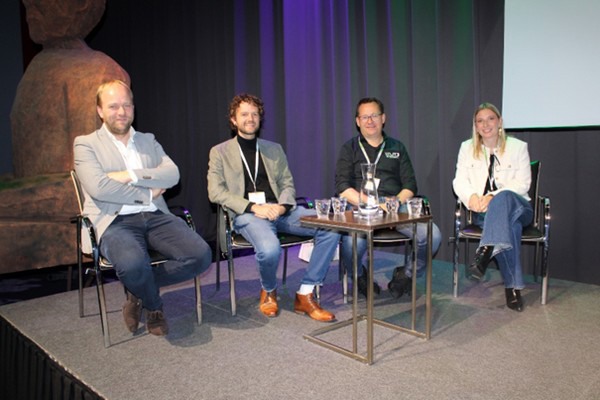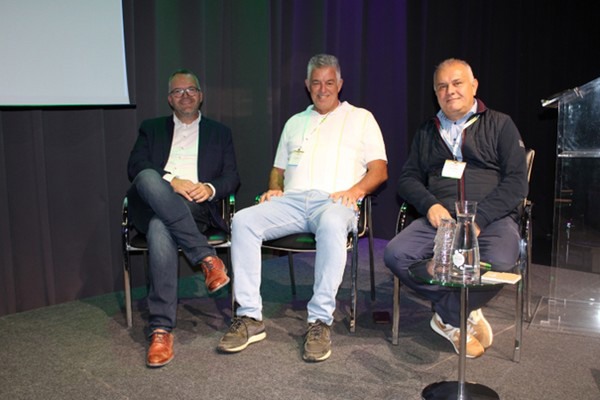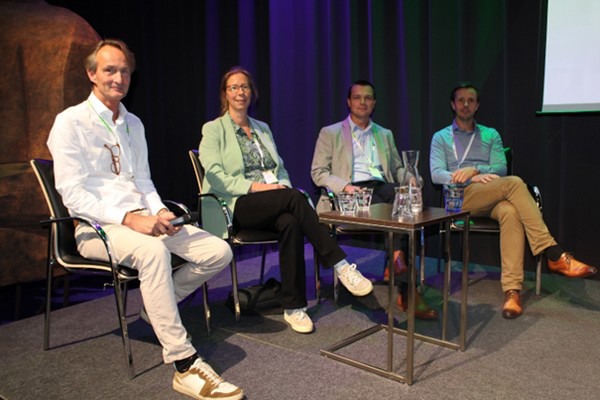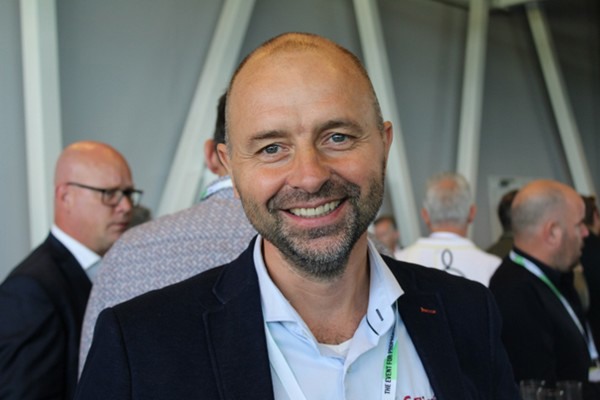On Tuesday, propagators from around the world came together to network and learn from each other. This year's event 'Propagate!2024' had the theme: 'From seed to success'. And that topic covered the load. We joined in for part of Tuesday and shared a report in words and pictures here.

Ton Habraken (Ludvig Svensson), Bram Wiggers (Track32), René Beerkens (Hoogendoorn) and Julia Erftemeijer (Artechno). View the entire photo report here.
Greenhouse climate and innovation
Ton Habraken breathes the principles of Plant Empowerment. The fan Climaflow fits right in with that. For growers, creating the perfect greenhouse climate is a huge challenge. Achieving an even temperature and ideal humidity is not easy. Ton: "With ClimaFlow, growers can keep their climate screens closed. Because the air in the greenhouse is mixed from above and below, you don't have dry spots in the crop. Both temperature and humidity are even, throughout the greenhouse."
Bram Wiggers (Track32) lets AI do the maths to count the usable seedlings. Letting AI loose on the imagery eliminates the need for manual counting. In the blink of an eye, their solution sees how many usable seedlings are in the tray. This imagery can be obtained in three ways: 'just' via an app on the phone, via a drone, or a tracker.
René Beerkens (Hoogendoorn) drew attention to their greenhouse control system IIVO. When equipped with intelligent algorithms, the greenhouse climate can be controlled at the micro level. Expected weather conditions are taken into account. Incidentally, five algorithms can be deployed with the greenhouse computer: ventilation, temperature, screening, lighting, and CO₂.
Julia Erftemeijer (Artechno) spoke about AVF+. This is an automated vertical growing solution designed for growing medium- to large-scale crops. In the climate cell, conditions for crop growth are created by controlling growth variables such as light, climate, irrigation, and nutrients. Julia: "The growth cycles are shorter than usual."

Henk-Jan van Ooyen (Iso Group) and John van Ruyven (JVR Tecmar) and Pjotr Slomiany. See the entire photo report here.
Robot and ToBRFV
Henk-Jan van Ooyen (ISO Group) impressed the audience with his short presentation on the grafting machine that can graft up to 4,000 plants per hour. Machine? Or is it more of a robot after all? Either way, Henk-Jan called this step forward in labor-saving a revolutionary one. And given the capacity of this machine, he might be right about that. To clarify, despite the high speed, no concessions are made to efficiency, quality, and hygiene.
The presentation by the gentlemen from JVR Tecmar was about encapsulating viruses in general. And during their talk, they zoomed in on ToBRFV. JVR Temar has a growth stimulator, Tobre, based on chitosan with a profiled particle distribution. This distribution creates the effect of compartmentalizing the cell and it then encapsulates the virus.
The virus cannot develop further. Prevention is better than cure, which is why Pjotr recommends using it at an early stage. John adds: "If the virus is already present, you can still see it. But it doesn't multiply anymore. It no longer has a hold on the crop. Production remains at the usual high level. The virus is eliminated. So there is a systemic acquired resistance."

Jan Kamper (Bayer), Corine de Groot (Bejo Zaden), James du Preez (Rijk Zwaan), and Ronald Visser (The Rootstock Company) View the entire photo report here.
Breeding companies
Bayer recently conducted research at the quarantine greenhouse in Wageningen on the importance of ToBRV resistance of rootstocks. No significant evidence was then found that rootstock resistance contributes to crop resistance. This applies to both leaf and fruit symptoms, shares Jan Kamper: "And it is indeed true that we do now have some resistance varieties in rootstocks. That has to do with the fact that, like all breeders, we assumed that this was important. The risk was too great not to take that into account. So did we. So in hindsight, the research shows that it was not necessary."
Most of The Rootstock Company's rootstocks are currently grown in South America. But that is certainly not the only region in the world where they operate. The introductory film showed that. Emsland Gemuse from Germany and Globe Plant from the Netherlands can count them among their customers. Special varieties have also been developed for Mexico. These take into account the extreme climate and can cope with the absence of crop rotation in outdoor cultivation. Ronald Visser: "You can imagine that that calls for different rootstock solutions."
James du Preez of Rijk Zwaan has a lot of contact with plant breeders in the Netherlands and Belgium. He was asked by Hans van Herk which substrate/substrate is best for the cucumber crop. A tricky one, because it's hard to say. It depends on so many factors. The conditions determine the choice of substrate. And not the other way around.
James does believe he has a preference for sowing directly in the block. This is to avoid transplants. That causes damage. James: "On the other hand, I also understand that this is a challenge. A challenge in space use as well as a logistical challenge."

Ad Kranendonk, Flier Systems. View the entire photo report here.
Flier Systems is one of the initiators of the event. Ad enjoyed the interaction he saw around him. "I see plant breeders from all over the world looking each other up. Last night was the same. I was sitting at the table with so many nationalities. The networking was already in full swing by then. Very nice to see that we can contribute to that."
View the entire photo report here.
For more information:
Ad Kranendonk
Propagate!
tel +31 (0)6 5155 5070
[email protected]
[email protected]
www.propagate.nl
